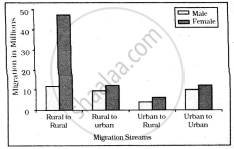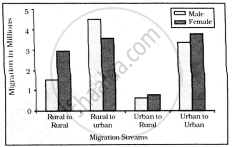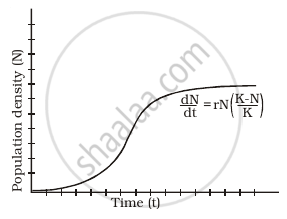Advertisements
Advertisements
प्रश्न
Examine the different aspects of the growth of population in India during 1951-1981 and 1981-2021.
उत्तर
- The decades 1951-1981 are referred to as the period of population explosion in India, which was caused by a rapid fall in the mortality rate but a high fertility rate of population in the country.
- The average annual growth rate was as high as 2.2 per cent. It is in this period, after the Independence, that developmental activities were introduced through a centralised planning process and economy started showing up ensuring the improvement of living condition of people at large.
- Consequently, there was a high natural increase and higher growth rate. Besides, increased international migration bringing in Tibetans, Bangladeshis, Nepalies and even people from Pakistan contributed to the high growth rate.
- In the post 1981 till present, the growth rate of country’s population though remained high, has started slowing down gradually.
- The growth rate of population is, however, still high in the country, and it has been projected by World Development Report that population of India will touch 1,350 million by 2025.
APPEARS IN
संबंधित प्रश्न
With the help of suitable diagram describe the logistic population growth curve.
If 8 individuals in a population of 80 butterflies die in a week, calculate the death rate of the population of butterflies during that period.
Examine the following statement and correct the incorrect one.
There is an adverse impact on manpower in the regions of out-migration.
Examine the following statement and correct the incorrect one.
Developing countries have an HDI of 1.
Give Geographical Reason.
The real progress of a country is understood with the help of the Human Development Index.
India’s population as per 2011 census is:
Which one of the following is not a push factor?
What are the three components of population change?
Push factors and pull factors of migration.
How long did the world take to increase its population from 5 billion to 6 billion?
Which country has the highest and lowest growth rate of the population respectively?
What is the impact of migration?
Distinguish between the place of origin and the place of destination.
Why do people migrate in large numbers from rural to urban areas in India?
The growth of population rate per decade is ______.
What is the average sex ratio In India (2011)?
The continent that has the highest growth rate of population.
What is the present annual growth rate of India?
Which of the following is not a pull factor?
The country having lowest growth rate of population.
Which one of the following is not a component of population change?
What is the present growth rate of population in the world?
Which of the following is not a push factor for migration?
Which are the components of population change?
Which of these statements is not true?
Which of the following attributes has not been adversely affected by Age and Skill selective migration?
Consider the following statements and choose the correct option from the given options:
1. Population grown rapidly during the sixteenth and seventeenth centuries.
2. Expansion of world trade during the sixteenth and seventeenth centuries is an important cause of it.

From the given graph, what condition can you infer about the developed countries?
Study the given graph carefully and answer the following question:

Intra-state Migration by place of Last Residence Indicating Migration Streams India, 2011

Inter-state Migration by Place of Last Residence Indicating Migration Streams India, 2011
Who dominates the intra-state migration of short distances?
Study the given graph carefully and answer the following question:

Intra-state Migration by place of Last Residence Indicating Migration Streams India, 2011

Inter-state Migration by Place of Last Residence Indicating Migration Streams India, 2011
Who dominates the inter-state migration of short distances?
The number of mice in a laboratory was 100 on a particular day. After one year their number increased to 120. Calculate the growth rate in the population.
Ratio between mortality and neutrality is called ______.
Exponential growth in plants win be expressed as ______.
Which of the following statement is true?
(i) CBR = Bi/P × 1000
(ii) COR = D /P × 1000
(iii) If birth rate is more than death rate, then CBR results in positive growth of population.
Which of these is a major cause of female migration in India?
Which of the following formula correctly depicts natural growth of population?
Which of the following forms the component of a nation?
India's population is larger than the total population of which of the following?
In the exponential growth equation Nt = Noert, e represents ______
If a population of 50 Paramoecium present in a pool increases to 150 after an hour, what would be the growth rate of population?
Comment on the growth curve given below.

Swathi was growing a bacterial colony in a culture flask under ideal laboratory conditions where the resources are replenished. Which of the following equations will represent the growth in this case?
(Where population size is N, birth rate is b, death rate is d, unit time period is t, and carrying capacity is K).
Which of the following may be interpreted as a spontaneous effort to achieve a better balance between population and resources?
When will be the growth of population positive in any place and in which one of the following conditions?
"Migration may be interpreted as a spontaneous effort to achieve a better balance between population and resources." Examine the statement in context of pull and push factors that influence migration.
Assertion (A): Population of a region does not change.
Reasoning (R): Birth rate, death rate and migration affect the population of a region.
Assertion (A): The population of a region does not change.
Reasoning (R): Birth rate, death rate and migration affect the population of a region.
